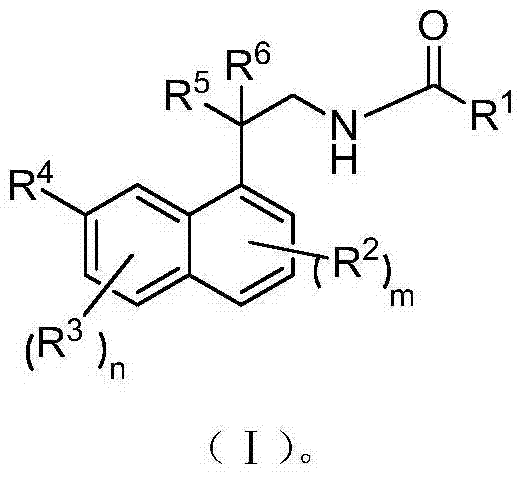Naphthalene derivatives and application thereof in drugs
A drug and pharmaceutical technology, applied in the application field of melatonin receptor agonist naphthalene compounds in the treatment of central nervous system dysfunction, can solve problems such as shortening sleep latency
- Summary
- Abstract
- Description
- Claims
- Application Information
AI Technical Summary
Problems solved by technology
Method used
Image
Examples
Embodiment 1
[0196] Example 1 N-(2-(7-methoxynaphthalene-1-yl)-2-methylpropyl)acetamide
[0197]
[0198] Step 1) Synthesis of 2-(7-methoxy-3,4-dihydronaphthalen-1-yl)acetonitrile
[0199] 7-methoxy-3,4-dihydronaphthalene-1 (2H)-one (5.00g, 28.37mmol), 2-cyanoacetic acid (3.62g, 42.56mmol), heptanoic acid (1.0mg, 7.09 mmol) and benzylamine (0.78mL, 7.09mmol) were reacted in toluene (30mL) in an oil bath at 140°C for 48h, then the reaction was stopped and cooled to 25°C. It was washed successively with saturated sodium bicarbonate solution (100 mL) and saturated brine (40 mL), and the organic phase was dried over anhydrous sodium sulfate after separation. After filtration, the filtrate was spin-dried under reduced pressure, and purified by column chromatography (petroleum ether / ethyl acetate (v / v)=50 / 1) to obtain the title compound as a yellow solid (5.44 g, 96.3%).
[0200] MS(ESI,pos.ion)m / z:200.2[M+1] + ;
[0201] 1H NMR (600MHz, CDCl 3 )δ7.12(d, J=8.4Hz, 1H), 6.77(dd, J=8.4...
Embodiment 2
[0219] Example 2 N-(2-(7-fluoronaphthalen-1-yl)-2-methylpropyl)acetamide
[0220]
[0221] Step 1) Synthesis of 2-(7-fluoro-3,4-dihydronaphthalen-1-yl)acetonitrile
[0222] The title compound of this step was prepared by referring to the method described in step 1 of Example 1, that is, 7-fluoro-3,4-dihydronaphthalene-1(2H)-one (2.00g, 12.18mmol), 2-cyanoacetic acid ( 1.55g, 18.27mmol), heptanoic acid (0.43mL, 3.05mmol) and benzylamine (0.33mL, 3.05mmol) were prepared by reacting in toluene (30mL), and the crude product was subjected to silica gel column chromatography (petroleum ether / ethyl acetate (v / v)=50 / 1), concentrated and dried to obtain the title compound as a yellow solid (1.03 g, 45.2%).
[0223] MS(ESI,pos.ion)m / z:188.2[M+1] + ;
[0224] 1H NMR (400MHz, CDCl 3 )δ7.13(dd, J=8.4,6.0Hz,1H),6.89(td,J=8.4,2.8Hz,1H),6.81(dd,J=9.6,2.8Hz,1H),6.33(t,J =4.4Hz, 1H), 3.45(dd, J=3.6, 1.6Hz, 2H), 2.76(t, J=8.0Hz, 2H), 2.36(m, 2H).
[0225] Step 2) Synthesis of 2-(7...
Embodiment 3
[0239] Example 3 N-(2-(7-methoxynaphthalen-1-yl)-2-methylpropyl)propionamide
[0240]
[0241] Step 1) Synthesis of N-(2-(7-methoxynaphthalene-1-yl)-2-methylpropyl) propanamide
[0242] The title compound of this step was prepared by referring to the method described in step 5 of Example 1, that is, 2-(7-methoxynaphth-1-yl)-2-methylpropan-1-amine (195 mg, 850 μmol), triethylamine (240μL, 1.70mmol) and propionyl chloride (90μL, 1.28mmol) were prepared by reacting in dichloromethane (15mL), and the crude product was subjected to silica gel column chromatography (petroleum ether / ethyl acetate (v / v)=2 / 1) , concentrated to dryness to obtain the title compound as a white solid (189 mg, 78.1%).
[0243] MS(ESI,pos.ion)m / z:286.3[M+1] + ;
[0244] 1 H NMR (600MHz, CDCl 3 )δ7.81(d, J=1.8Hz, 1H), 7.77(d, J=9.0Hz, 1H), 7.69(d, J=8.4Hz, 1H), 7.41(d, J=7.8Hz, 1H) ,7.30(t,J=7.8Hz,1H),7.15(dd,J=9.0,2.4Hz,1H),3.98(s,3H),3.79(d,J=5.4Hz,2H),2.27(q, J=6.0Hz, 2H), 1.55(s, 6H), 1.02...
PUM
 Login to View More
Login to View More Abstract
Description
Claims
Application Information
 Login to View More
Login to View More - R&D
- Intellectual Property
- Life Sciences
- Materials
- Tech Scout
- Unparalleled Data Quality
- Higher Quality Content
- 60% Fewer Hallucinations
Browse by: Latest US Patents, China's latest patents, Technical Efficacy Thesaurus, Application Domain, Technology Topic, Popular Technical Reports.
© 2025 PatSnap. All rights reserved.Legal|Privacy policy|Modern Slavery Act Transparency Statement|Sitemap|About US| Contact US: help@patsnap.com



